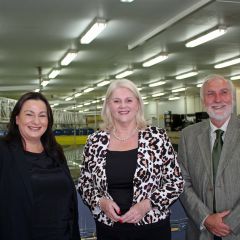The University of Tasmania will lead the largest ever Cooperative Research Centre (CRC), bringing together expertise in seafood, renewable energy and offshore engineering to transform Australia’s blue economy.
Announced in Launceston on Tuesday, 16 April by Minister for Industry, Science and Technology Karen Andrews, the Blue Economy CRC aims to drive an evolution in marine-based industries, unlocking enormous economic, environmental and technological benefits.
The $329 million research project is a 10-year collaboration between 45 national and international partners from industry, research and government, underpinned by a $70 million cash investment from the Federal Government.
The Tasmanian Government is also a supporting partner, which has been a key factor in gaining local industry involvement.
Vice-Chancellor Professor Rufus Black said the Launceston-based Blue Economy CRC would build on Tasmania’s and the University’s distinctive strengths in aquaculture and marine ecology, offshore engineering and marine renewable energy.
“This is big blue sky thinking fused with practical, impactful research to answer one of our planet’s most critical questions: how can we sustainably feed and power ourselves from the world’s oceans,” Professor Black said.
The Blue Economy CRC imagines a future where integrated seafood and renewable energy production systems operate offshore and where the community and industry have confidence they are safe, reliable, efficient and environmentally responsible.
“This work will leave a compelling legacy of high-impact research, a competitive advantage for Australian industry, and innovation, collaboration and leadership on a global scale.
“And it will further solidify Northern Tasmania as an important hub for marine engineering and ocean renewable energy – a place where we can imagine new futures and chart a course to reach them.”
The Blue Economy CRC head office will be hosted at the University of Tasmania’s Launceston campus, supporting a research community of 50 PhD students and 50 postdoctoral research fellows throughout Tasmania and with partner organisations nationally and internationally.
Blue Economy CRC Research Director, Australian Maritime College Associate Professor Irene Penesis said the program was unique in bringing together aquaculture, renewable energy and offshore engineering.
“Australia has the world’s third largest exclusive economic zone and is positioned adjacent to the largest markets for seafood and energy,” Associate Professor Penesis said.
“But with over 80 per cent classified as offshore, industries must be enabled to move from the coast zone into more exposed operating environments before we can secure this major opportunity for the nation.
The CRC will translate new developments in science and technology into commercial activity in ways that support our industry partners to create advantage in this evolving market.”
The focus of the first five years of the program will be developing and testing new offshore aquaculture and renewable energy technologies, which will then be brought together on a single platform to demonstrate the economic and environmental benefits of co-location.
“The offshore research platform will act as a living laboratory where we can vertically integrate renewable energy and aquaculture technologies with other engineering activities, such as autonomous and remotely-operated vehicles, in a proof of concept for how we could operate in the future,” Associate Professor Penesis said.
“It will be the first offshore research platform of its kind in the world and we’re confident that it will deliver ground-breaking research alongside commercially viable new materials, concepts, prototypes and monitoring systems – all informed by best practice and delivered in an environmentally sustainable way.”
While the solutions will be developed in the immediate term for the Tasmanian offshore environment, the involvement of international partners will help move the development of new technology to global markets.
The CRC is expected to generate more than $4 billion for the national economy.
IMAS Professor Stewart Frusher said the development of new environmental guidelines and policies was an integral part of the research program.
“This CRC provides a unique opportunity to simultaneously support policy development, environmental monitoring and management while securing sustainable and ethical industry expansion,” Professor Frusher said.
“Australia has a global reputation for quality, safe and sustainable seafood and management of its marine natural resources and biodiversity.
“The CRC will provide governance for the new industry capability to position Australia as the market leader in this burgeoning area.”
(Photo): Blue Economy CRC Research Director, Associate Professor Irene Penesis, Minister for Industry, Science and Technology Karen Andrews and Institute for Marine and Antarctic Studies Professor Stewart Frusher.
Published on: 16 Apr 2019

